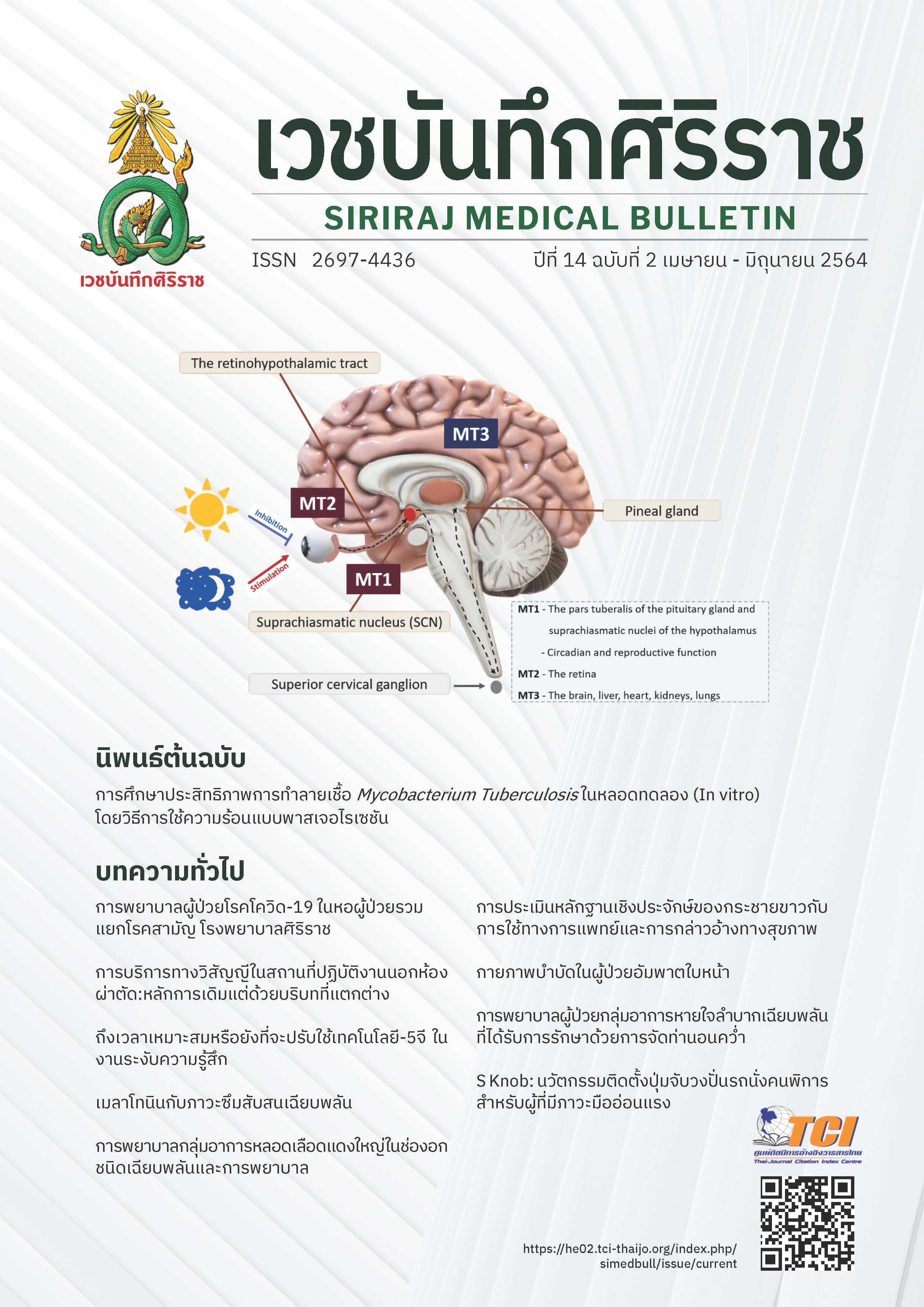Nursing Care for Patients with Acute Thoracic Aortic Syndrome and Nursing
Main Article Content
Abstract
Patients with acute thoracic aortic thoracic syndrome is defined as emergency conditions and leading causes of death in cardiovascular disease. The symptoms include acute onset of severe chest or back pain is the most common, syncope, neurological deficit including stroke and paraplegia, acute congestive heart failure, myocardial ischemia, lower extremity ischemia. There are patients after being diagnosed must receive emergent treatment to reduce complication and decrease mortality rate. Most will be treated with surgery is the aortic replacement or thoracic endovascular stent graft. But there are a number of patients who died while waiting for surgery because need to be transfer to expertise in cardiac surgery center. There for Nursing preoperative is very important since assessing symptoms and physical examination from the beginning nursing management after being diagnosed to prevent the severity of the disease including monitoring and manage complications from disease progression to reduce disability and mortality.
Article Details

This work is licensed under a Creative Commons Attribution-NonCommercial-NoDerivatives 4.0 International License.
References
โอภาส ศรัทธาพุทธ. หลอดเลือดในช่องอกและการฉีกเซาะของผนังเอออร์ตา.ใน: โอภาส ศรัทธาพุทธ. สาระสำคัญทางศัลยศาสตร์หัวใจ. พิมพ์ครั้งที่ 1. ปทุมธานี. มหาวิทยาลัยธรรมศาสตร์ . 2561: หน้า 311-32.
Suksan Kanoksin. Management of complication of aortic dissection. หน่วยศัลยกรรมทรวงอกและหัวใจ ภาควิชาศัลยศาสตร์ คณะแพทยศาสตร์วชิรพยาบาล มหาวิทยาลัยกรุงเทพมหานคร (มหาวิทยาลัยนวมินทราธิราช) สมาคมศัลยแพทย์ทรวงอกแห่งประเทศไทย การอบรมวิชาการระยะสั้น ครั้งที่ 14 [เข้าถึงเมื่อ ปี 2563 เดือน มกราคม วันที่ 15] Available from :http://thaists.org/news_files/news_file_495.pdf
Erbel R, Aboyan V, Boileau C, et.al. 2014 ESC Guidelines on the diagnosis and treatment of aortic diseases. European Heart Journal 2014; 35: 2873–2926.
Bushnell J, Brown J. Clinical Assessment for Acute Thoracic Aortic Dissection. Annals of Emergency medicine 2005; 41: 90-3.
Coady MA, Rizzo JA, Goldstein LJ, Elefteriades JA. Natural history, pathogenesis, and etiology of thoracic aneurysm and dissections. CARDIOLOGY CLINICS OF NORTH AMERICA 1999;17(4):615-35.
Fukui T. Management of acute aortic dissection and thoracic aortic rupture. Intensive Care 2018; 6(15):1-8.
Almeida GF, Vegni R, Japiassú AM, Kurtz P, Drumond LE, Freitas M, et al. Postoperative complications of surgically treated ascending aortic dissection. Rev Bras Ter Intensiva 2011; 23(3):304-311.
Matthew LW., et.al. Aortic Dissection as a Complication of Cardiac Surgery: Report From The Society of Thoracic Surgeons Database. Ann Thorac Surg 2010; 90:1812–7.
Bossone E, LaBounty MT, Eagle AK. Acute aortic syndromes: diagnosis and management, an update. European Heart Journal 2018; 39: 739–749.
Morris HJ, Mix D, Cameron JS. Acute Aortic Syndromes: Update in Current Medical Management. Curr Treat Options Cardio Med 2017; 19: 29.


